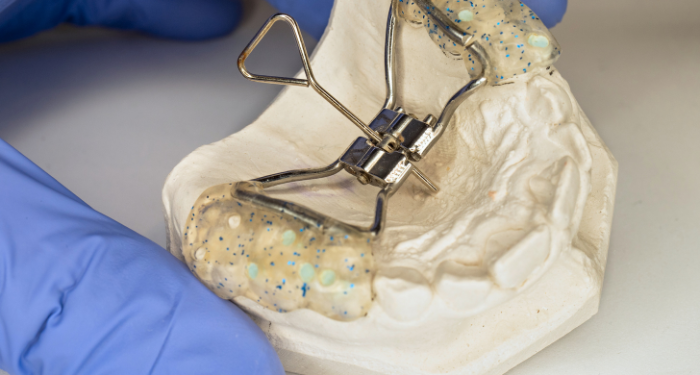My understanding of palatal expansion started long before I ever recommended a consult to a patient. During my first myofunctional therapy course, I suddenly recognized the signs of a tongue-tie in my own baby.
That moment connected everything for me: the tongue-tie, the narrow palate, the disrupted oral function. It was the beginning of our own expansion journey.
If you are here, you have probably had your own eye-opening moments, too. Once you step into the world of oral function, you quickly realize there are many different kinds of palatal expanders.
It can feel overwhelming to understand what they do or why a specialist recommends one option over another.
My goal is not to tell you which choice is best. That is up to the dentist or orthodontist. Instead, I want to help you understand the overall landscape so you can follow what is being recommended and why.

What Is Palatal Expansion
Palatal expansion is the process of widening the maxilla, or upper jaw. The maxilla forms:
- the roof of your mouth
- the floor of your nose
- part of your airway
Expanding the palate is not simply about straightening teeth. It often leads to improvements in:
- nasal airflow
- tongue placement on the palate, which promotes nasal breathing
- mouth breathing, snoring, sleep-disordered breathing, and even articulation
- overall craniofacial growth
Even a few millimeters of expansion can increase nasal volume. Expansion also creates the space the tongue needs for therapy to be more effective.
The Main Types of Palatal Expanders
There is no single approach that works for everyone. Expanders are chosen based on:
- age be
- maturity
- airway needs
- growth needed
- dental alignment
Below are the most common categories you will hear about.
1. Rapid Palatal Expanders (RPE)
Haas and Hyrax Expanders
These are the classic metal expanders most people imagine.
How they work:
A central screw is turned daily with a key, applying outward pressure to widen the palate.
Best for:
- children and younger teens
- crossbites
- dental crowding
- early airway intervention
What to expect:
- predictable expansion
- rapid changes within weeks
- a temporary gap between the front teeth
- short-term speech or eating adjustments
2. MARPE and MSE (Micro-Implant Assisted Expanders)
This category is often used for older teens and adults.
What they are:
- MARPE: Maxillary Skeletal Expander
- MSE: Micro-Screw Expander (a type of MARPE but not the same thing)
These devices use tiny mini-implants that anchor expansion forces directly into the bone. This allows true skeletal expansion in adults (although the device is only as good as the provider trained to use it!) whose palatal sutures are typically fused.
Who it is for:
- older teens, often 15 and up
- adults with narrow palates
- individuals with nasal obstruction or sleep concerns
- anyone who needs true skeletal expansion rather than dental tipping
Benefits:
- increases nasal volume
- widens the airway
- reduces dental tipping
- can significantly improve breathing and sleep
- often guided with CBCT imaging for accuracy
3. Slow and Epigenetic Expanders
These create gentler, slower changes and are often paired with myofunctional therapy and airway support.
DNA Appliance (Daytime Nighttime Appliance)
- Uses light forces to encourage natural bone remodeling
- Worn several hours a day and overnight
- Often helpful for TMJ issues, airway needs, and narrow palates
Schwartz Expander
- Removable acrylic device
- Turned once or twice per week
- Best for mild to moderate expansion
- Ideal for kids who can manage removable appliances
4. Lightwire Appliances
These use gentle, continuous forces and can be especially helpful for sensory-sensitive children.
ALF Appliance (Advanced Lightwire Functional)
- Works with the neuromuscular system
- Supports cranial balance
- Helpful for airway, feeding, and oral posture
- Requires regular adjustments
Crozat and Farrell Bent Wire Systems
- Provide mild to moderate expansion
- Encourage proper tongue function
- Often paired with craniosacral therapy
- Follow a biologically guided, slower approach
5. Myofunctional Orthodontic Systems
These systems rely on functional training rather than mechanical force. They are not true expanders but can support oral habits and patterns.
Myobrace
A soft silicone appliance often marketed for habit correction and early intervention. In clinical practice, it can serve as a placeholder or a habit-awareness tool. It is not a primary expansion device and usually needs additional airway or orthodontic support for structural change.
Best used for:
- guiding oral habits
- early pattern awareness
- maintenance when full expansion is not indicated
MyoMunchee
A medical-grade silicone chewing appliance that supports oral tone, chewing strength, jaw development, and oral hygiene.
Used for about 5 to 10 minutes daily.
FAQs
Can adults really expand their palate?
Yes. MARPE and MSE allow true skeletal expansion in adults.
Is expansion painful?
Most people describe it as pressure more than pain. Some soreness is normal at the beginning.
How long does it take?
Active expansion usually lasts 2 to 6 weeks. Stabilization takes multiple months following.
Does everyone get a gap between the front teeth?
Most screw-turn expanders create a temporary gap. It closes during treatment without reversing the skeletal expansion gained. Lightwire and functional systems usually do not create a gap.
Is expansion only for orthodontic issues?
No. It also supports airway health, sleep, craniofacial development, and adequate tongue space.
Let’s wrap this up…
If an orthodontist has recommended palatal expansion, it can be one of the most impactful interventions for airway health, facial growth, and oral function. Whether you are exploring options for your child or considering your own airway journey, understanding the different types of expanders and how they support breathing and growth helps you make informed, collaborative decisions.
Better breathing starts with understanding your options, and you do not have to navigate them alone.

